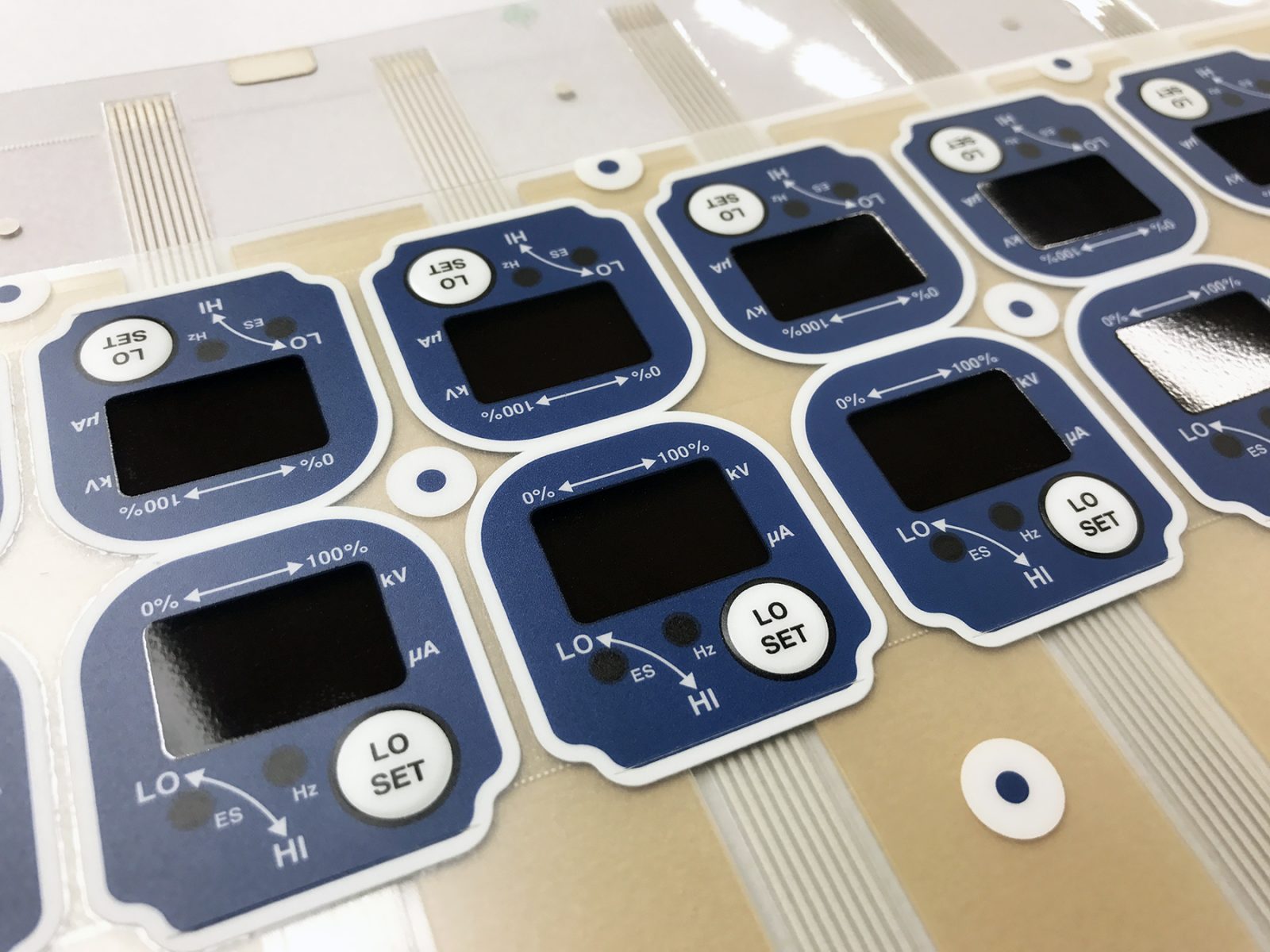Reliable Membrane Switch Manufacturer for Premium Control Panels
Just How Membrane Switch Technology Works and Its Role in Individual User Interface Layout
Membrane button innovation is an innovative method that incorporates split materials for touch-sensitive input. When pressed, its style is composed of graphic overlays, conductive layers, and sticky parts that interact. This communication not only completes an electric circuit yet likewise affects the total individual experience. Comprehending the intricacies of this innovation exposes its significant influence on interface layout, prompting questions concerning its applications and future growths in different markets.
Comprehending Membrane Switch Innovation
Membrane button modern technology serves as an essential part in modern user interface design. This innovation integrates graphic overlays, touch-sensitive membrane layers, and circuit layers to develop a compact, reputable input technique for different tools. The style generally contains multiple layers, including a printed graphic layer that enables individuals to communicate with the tool through responsive feedback. Membrane buttons are recognized for their durability, resistance to dampness, and simplicity of cleaning, making them appropriate for atmospheres where standard mechanical buttons may fail. Their low-profile style allows seamless integration into gadgets, adding to a smooth appearance. On top of that, Membrane buttons can be customized with various colors, structures, and symbols, enhancing individual experience and aesthetic charm. This versatility makes them popular in consumer electronics, medical tools, and commercial controls, where instinctive interaction is crucial. In general, Membrane switch technology stands for a significant advancement in just how customers involve with digital user interfaces.
Trick Elements of Membrane Switches Over
Membrane switches over include several essential elements that add to their capability and layout. The conductive layer products, adhesive and support layers, and visuals overlay design each play an essential duty in guaranteeing suitable performance and individual interaction. Comprehending these parts is crucial for reliable individual interface layout.
Conductive Layer Materials
Conductive layer materials play a necessary duty in the functionality and reliability of Membrane switches. These materials are accountable for finishing electric circuits when stress is related to the button. Normally, a combination of conductive inks, such as silver or carbon, is used to develop these layers. Silver conductive ink is favored for its remarkable conductivity and resilience, while carbon ink is usually used for affordable applications. The choice of product influences not only the electrical performance but likewise the total life expectancy of the switch. Additionally, the thickness and make-up of conductive layers can affect tactile feedback and switch actuation. Choosing the suitable conductive product is crucial for ensuring excellent performance in diverse interface applications.
Glue and Assistance Layers
Glue and support layers are important parts that contribute to the structural stability and capability of Membrane buttons. These layers provide a robust foundation, guaranteeing that the numerous components of the Membrane switch stay safely bound and correctly straightened throughout their functional life. The sticky layer promotes the add-on of the button to the underlying surface, using resilience against environmental elements such as wetness, temperature variants, and mechanical tension. Support layers enhance the switch's rigidness, protecting against contortion during use and contributing to a consistent tactile action. With each other, these components play an essential duty in maintaining the performance and longevity of Membrane buttons, eventually influencing the total individual experience in interface design.
Graphic Overlay Design
Although typically ignored, graphic overlay layout plays a crucial function in the performance and visual appeals of Membrane buttons. This style mostly works as the interface in between the individual and the electronics, providing both visual appeal and operational quality. Efficient visuals overlays utilize color, typography, and icons to lead individuals in understanding and steering controls device features. The option of materials influences sturdiness and responsive feedback, making certain the overlay holds up against wear while preserving an enjoyable user experience. Furthermore, precise alignment of the overlay with the underlying elements is vital for optimal performance. Finally, thoughtful visuals overlay style enhances functionality, contributes to brand name identity, and ultimately influences customer fulfillment in devices using Membrane button modern technology.
The Manufacturing Process of Membrane Switches Over
The manufacturing procedure of Membrane changes involves several important actions that assure capability and durability. A graphic overlay is created, integrating user interface components and branding. This overlay is published onto an adaptable substratum, commonly polyester or polycarbonate, using precision printing techniques to ascertain clarity and color accuracy.Next, glue layers are used, complied with by the combination of conductive traces, usually made from silver or carbon, which are important for electric connection. These traces are screen-printed or etched onto a separate layer. After this, a spacer layer is included to develop the required space between the circuit and the overlay layer, permitting tactile comments when activated.Finally, the parts are assembled and evaluated for top quality guarantee, ensuring that each Membrane button meets the needed specifications for efficiency and integrity. This precise process causes a durable product fit for various applications in individual interface layout.
Benefits of Using Membrane Switches

Membrane switches offer numerous advantages that make them a recommended choice in customer interface design. One substantial benefit is their light-weight and compact nature, enabling streamlined styles in various applications. In addition, Membrane buttons offer a sealed interface, securing against dust, dampness, and contaminants, which enhances resilience and reliability. They are additionally highly personalized, enabling designers to create one-of-a-kind graphics and designs customized to specific customer needs.Another benefit is their cost-effectiveness, as they usually need much less material and labor contrasted to standard switches. The responsive comments of Membrane switches can be engineered to improve customer experience, supplying a rewarding reaction without the mass of mechanical components. Additionally, Membrane switches can be easily incorporated into varied environments, such as clinical devices, commercial devices, and customer electronics. Generally, these benefits highlight the growing popularity of Membrane switches in modern-day individual interface style.
Applications in Different Industries
Widely used across numerous markets, Membrane switch modern technology has located its place in applications varying from medical tools to consumer electronic devices. In the healthcare industry, these buttons are integral to gadgets such as analysis devices and person monitoring systems, using you can look here sturdy, easy-to-clean user interfaces that hold up against sanitation procedures. The vehicle sector employs Membrane buttons in dashboards and control board, supplying reliable procedure in tough environments.Consumer electronics, including home devices and pc gaming consoles, advantage from the streamlined style and customizability of Membrane switches, improving user interaction. In addition, commercial machinery uses these switches for control board, making sure resistance to dirt and moisture while keeping functionality.Moreover, the aerospace and armed forces industries utilize Membrane switches for rugged applications, where dependability and efficiency are essential. Overall, Membrane switch technology serves diverse industries by integrating functionality, durability, he said and visual appeal, making it a flexible choice for modern-day user interfaces.

Creating Interface With Membrane Switches Over
When making interface with Membrane buttons, mindful factor to consider of both performance and aesthetic appeal is necessary. Membrane switches supply a smooth, low-profile layout that can improve aesthetic allure while keeping usability. Designers have to focus on switch layout, making sure user-friendly placement for ease of operation. The tactile feedback given by the Membrane switch is crucial; it can impact user satisfaction and total experience.Additionally, shade and visuals elements ought to straighten with the brand identity, strengthening acknowledgment and familiarity. Picking durable products that withstand damage is likewise vital, as longevity adds to use in time. Incorporating backlighting can improve exposure in various illumination problems, additionally enhancing customer communication. Ultimately, a well-designed Membrane switch interface equilibriums both kind and feature, making certain that the user experience is both engaging and efficient, fulfilling the demands of varied applications across markets.
Future Trends in Membrane Switch Technology
As Membrane button innovation evolves, the assimilation of clever performances is coming to be significantly popular. These advancements enable improved interactivity and connectivity within interface (membrane switch manufacturer). In addition, the shift towards eco-friendly products reflects a growing dedication to sustainability in layout techniques
Smart Membrane Switches

Eco-Friendly Products Use
In the middle of the improvements in Membrane switch innovation, a substantial fad is arising in the direction of the use of environment-friendly products. Suppliers are increasingly prioritizing sustainability by incorporating non-toxic inks and eco-friendly plastics, lowering environmental impact. This shift not only aligns with global environmental requirements however likewise addresses consumer demand for greener products. Developments in material science have allowed the advancement of long lasting, environment-friendly alternatives that preserve performance without compromising quality. These materials offer comparable functionality to typical alternatives while decreasing waste and poisoning. As markets end up being much more eco-conscious, the integration of sustainable methods in Membrane button manufacturing is expected to rise, reinforcing a dedication to ecological obligation and leading the way for more sustainable user interface options in the future.
Often Asked Questions
Exactly How Do Membrane Changes Differ From Standard Mechanical Switches?
Membrane changes vary from typical mechanical switches primarily in construction and operation. They utilize flexible layers that develop a secured user interface, whereas mechanical switches count on physical motion and call, resulting in distinct resilience and tactile comments qualities.
Can Membrane Switches Over Be Personalized for Certain Applications?
Membrane buttons can certainly be personalized for specific applications - membrane switch manufacturer. Producers make them to fulfill unique demands, enabling for tailored layouts, graphics, and performances that enhance individual communication and fit certain functional needs effectively
What Is the Life-span of a Membrane Switch?
The life-span of a membrane switch generally ranges from 1 to 5 million actuations, depending upon variables such as material high quality, environmental conditions, and use regularity. Normal screening can assist identify its long life and dependability in applications.
Are Membrane Changes Resistant or water resistant to Chemicals?
Membrane switches can be developed to be water-proof and resistant to chemicals, depending upon the products utilized and producing processes. Correct sealing and protective coverings improve their toughness in numerous ecological problems and applications.
Exactly How Do Membrane Switches Influence Gadget Energy Intake?
Membrane switches can greatly affect gadget energy usage by ensuring effective operation. Their low power requirements throughout activation assistance reduce power usage, adding to longer battery life and overall better effectiveness in electronic devices. Membrane buttons are known for their longevity, resistance to wetness, and ease of cleansing, making them appropriate for environments where typical mechanical buttons may stop working. The auto industry employs Membrane buttons in dashboards and control panels, giving dependable operation in difficult environments.Consumer electronics, including home devices and gaming consoles, advantage from the sleek design and customizability of Membrane switches, boosting individual interaction. Furthermore, commercial equipment utilizes these buttons for control panels, guaranteeing resistance to dust and dampness while maintaining functionality.Moreover, the aerospace and armed forces markets make use of Membrane buttons for sturdy applications, where reliability and performance are important. The advancement of Membrane button modern technology is entering an exciting stage with the introduction of clever Membrane switches, which incorporate innovative functions and performances. Membrane switches differ from standard mechanical buttons primarily in building and operation.